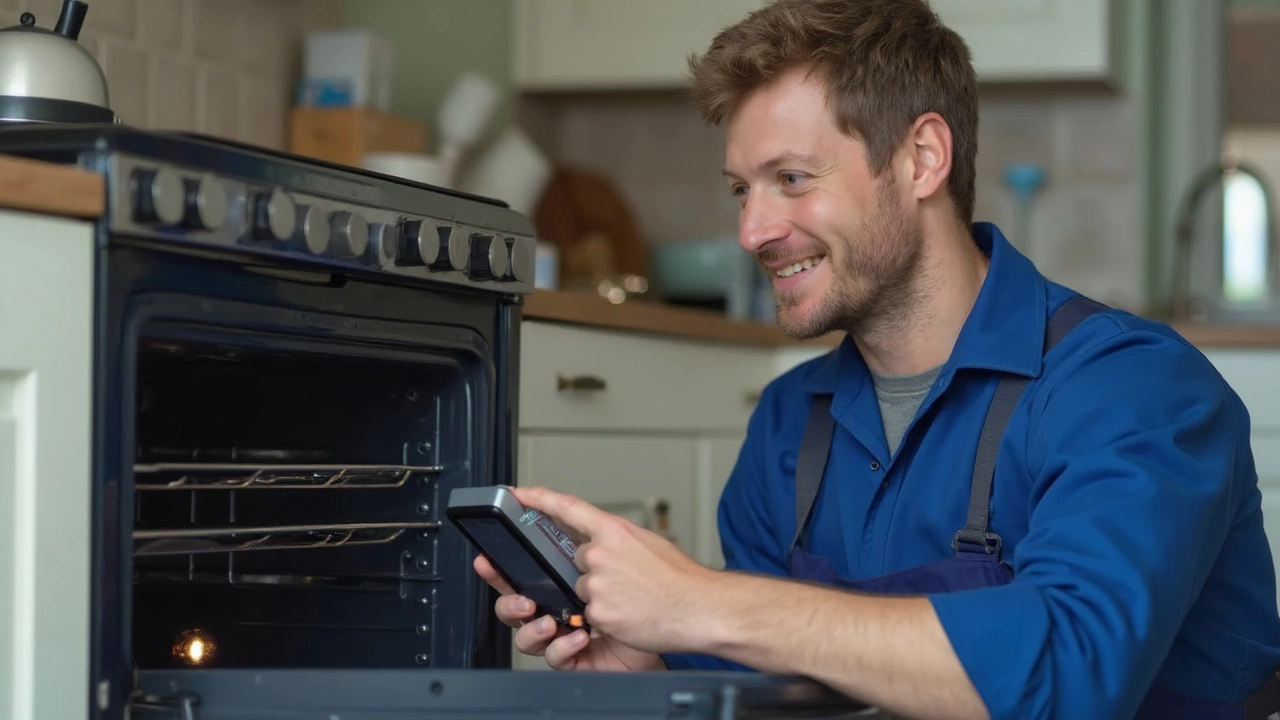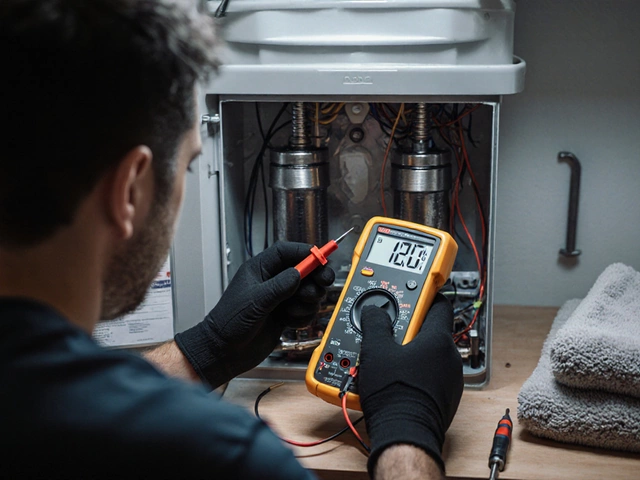Ever opened the oven door on pizza night and got hit with cold air instead of that toasty wave? Electric ovens aren’t complicated in theory—heat up, keep things steady, cook the food. But when something goes wrong, it can be hard to tell if you need a screwdriver, a whole new oven, or just a day off dinner duty.
Good news: not all oven problems mean panic or huge repair bills. A lot of fixes, like swapping out a dodgy heating element or cleaning dirty contacts, don’t require special skills or fancy gear. In fact, about a third of home oven repairs are quick jobs you can pull off with basic tools and a YouTube video for backup.
But before grabbing that Phillips head screwdriver, it helps to know what usually breaks down in electric ovens, which warning signs mean an easy fix, and which ones are red flags. Knowing the difference saves you time, keeps things safer, and gets you back to baking brownies faster.
- Why Ovens Break Down
- Common Electric Oven Problems
- Quick Fixes Anyone Can Try
- When It’s Not a DIY Job
- Tools and Safety Tips
- How to Decide: Fix or Replace?
Why Ovens Break Down
Kitchen appliances put in the daily grind, but electric ovens have it especially tough. They face regular high heat, sticky splatters, and sometimes a little slap when the door won’t quite shut right. Over time, these things add up and wear down the oven’s basic parts.
Some parts see more action (and breakdowns) than others. Heating elements inside the oven take the brunt—they’re either glowing hot or cooling down, a cycle that eventually causes cracks or burnouts. Thermostats and sensors have to read temps constantly and will slip out of calibration if they get coated in grime or just wear out. Oven door gaskets aren’t immune either. If they don’t seal properly, the inside won’t hold heat, and other parts have to work overtime to catch up.
- Oven repair centers say that failing elements—either the main bake or broil ones—are the most changed part on any electric oven.
- Loose or frayed wiring is another common issue, made worse by heat and old age. It leads to random shut-offs or power that simply won’t turn on, even if the rest of the kitchen is fine.
- Knobs, buttons, and control boards are at risk too, especially with lots of use or after a big spill. Spilled liquid can short a circuit or make the electronics act up.
- Finally, built-in fans (in convection models) can gum up or stop spinning, causing uneven cooking and longer bake times.
| Problem Area | Percent of Cases |
|---|---|
| Heating Element Burnout | 35% |
| Faulty Thermostat or Sensor | 20% |
| Electrical Wiring Damage | 18% |
| Control Board or Knob Issues | 16% |
| Fan or Motor Problems | 11% |
The main takeaway: most oven breakdowns aren’t some mysterious disaster—they usually track back to a handful of super common parts wearing out or getting dirty. Spotting what’s most likely has a huge impact on how quickly (and cheaply) you’ll get your oven working again.
Common Electric Oven Problems
Electric ovens aren’t shy about showing when something’s wrong. Some issues pop up so often that repair guys can almost guess the fix before they even see your oven. Here’s what happens most:
- Oven not heating up: This is the classic complaint. The usual suspects? The heating element has burned out, the thermostat can’t sense temperature right, or the wiring has worked loose.
- Uneven cooking or hot spots: If your cookies are burnt on one side, the heating element might be half-working, or there could be a faulty temperature sensor throwing things off.
- Oven won’t turn on at all: Before you panic, double check the breaker. If that’s fine, you could be dealing with a busted control board or a failed fuse inside the oven.
- Door won’t close properly: Sometimes it’s something simple like crumbs jamming the latch, but bent hinges or a worn-out door gasket can also be the reason.
- Dials, buttons, or digital displays not responding: If only one button or function is out, the control board probably has a bad spot. If nothing responds, check for a loose connection or power issue.
- Strange noises, burning smells, or sparks: These should never be ignored. These symptoms usually mean there’s a wiring fault or a shorted heating element, and that’s a job for a pro.
Knowing what the most common oven repair issues are puts you one step ahead. If your oven’s acting up, it’s probably for one of these reasons—not random bad luck. The trick is noticing the small warning signs before you’re stuck with a half-baked dinner and no backup plan.
Quick Fixes Anyone Can Try
Sometimes the reason your oven isn’t working is dead simple—and you don’t need to call in a pro just yet. Here are the fixes that usually do the trick when your oven’s acting up, especially if you’re dealing with the classics like the oven not heating, odd smells, or a fan that suddenly sounds like a blender full of marbles.
- Check the power supply: Sounds obvious, but sometimes plugs get knocked loose or circuit breakers trip. Make sure your oven is plugged in and the breaker is set. Over 40% of “broken” oven calls turn out to be power issues.
- Test the heating elements: If only one part (like the broil or bake part) isn’t heating, look at the electric element. If it’s cracked or has obvious burns, it probably needs swapping. Replacements are cheap—usually $20 to $50.
- Clean the oven thoroughly: Grease buildup can shut down heating sensors. A dirty temperature sensor can mess up cooking times as well. A gentle wipe with a soft cloth and some vinegar is all you need most days.
- Set the clock and timer: Lots of ovens won’t switch on if the clock isn’t set—sounds wild, but it’s true. Double check your timer and clock before blaming the appliance.
- Check the oven door: Sensors on the door can stop an oven from heating if it thinks the door’s open. Make sure it’s fully closed and the latch isn’t blocked by a rogue bit of food.
Here’s a quick look at what causes most basic oven headaches and what you can do right away:
| Problem | Possible Cause | Easy Fix |
|---|---|---|
| Oven won’t heat | Tripped breaker, faulty element, unlatched door | Check breaker, inspect element, close door properly |
| Burning smell | Old food, spilled grease | Clean oven, remove debris |
| Timer not starting | Clock not set | Set time and retest |
| Light won’t turn on | Burnt bulb | Replace bulb (most take a standard oven bulb, $5–10) |
Bottom line: if the problem is tied to power, cleaning, or a visible part like the element or bulb, chances are you’re only 10–20 minutes from a working oven again. And don’t forget—using the oven repair tips in your manual actually gets results. About half the time, the user manual has a fix most people overlook. So dig it out if you’re stuck.

When It’s Not a DIY Job
Some oven problems look simple, but diving in without experience can turn a headache into a disaster. Messing with wires or major components in your oven can get dangerous fast. Electric ovens run on a lot of voltage—way more than what you get from a toaster or lamp. If you don’t shut off power at the breaker first, there’s a real risk of shock, or even fire.
If your oven trips the breaker, sparks, smells like burning plastic, or blows fuses over and over, step back. These clues often mean something’s up with the wiring, control board, or another big part. At this point, it’s safer to get a professional to check it out. According to the National Fire Protection Association, faulty home appliances—especially ranges and ovens—spark over 7,000 house fires in the U.S. each year. That’s not a risk you want to take for the sake of saving a few bucks.
Here’s another red flag: display panels or thermostats that go wild (flashing codes or random numbers), especially if pressing "reset" or disconnecting power doesn’t help. Faulty electronics almost always require advanced tools and know-how, which most regular folks don’t have lying around.
- Your oven is built-in and access is tight (removing it might damage your cabinets or wiring)
- The door won’t lock or unlock during the self-clean cycle
- You smell gas (for dual-fuel models or gas ovens)
- The control board is acting erratic or there’s visible damage to the wiring
Here’s a quick look at the usual line between DIY and professional jobs:
| Problem | DIY Friendly? | Call a Pro? |
|---|---|---|
| Heating element replacement | Usually | Only if wiring is melted |
| Broken door glass | No | Yes |
| Sparking, burning smells, or tripped circuit | No | Yes |
| Control panel glitch | No | Yes |
| Oven not heating at all despite power | Sometimes | Yes, if element is okay |
So, don’t risk your safety or your kitchen—if you run into anything involving the control board, electrical smell, or stubborn error codes, ring up a licensed appliance tech. That’s where the oven repair experts earn their keep.
Tools and Safety Tips
If you’re thinking about tackling a fix on your own oven, a little prep makes life way easier—and safer. First and most important: always unplug your oven from the wall before touching anything inside. Electric ovens pack a real punch, even when switched off at the controls. Skipping this step is how people end up in the ER, and that’s not a fun story to tell.
So what do you actually need to fix most electric oven problems? For simple jobs, you’ll want these tools on hand:
- Screwdriver set (mostly Phillips and flathead, nothing fancy)
- Needle-nose pliers (for getting at tricky wires)
- Multimeter (checks if wires and elements are getting power)
- Nut driver (some ovens use bolts instead of screws)
- Work gloves (protect your hands from sharp edges)
- Flashlight or headlamp (it gets dark behind appliances)
Don’t forget to snap a photo before you unplug anything. People think they’ll remember where wires go. Trust me, you won’t.
Now about safety. Besides unplugging your oven repair project, never work on an oven that’s just been used—heating elements stay hot way longer than you think. Use insulated tools if you’re testing circuits, and keep water away from everything. If you smell gas when working with a dual-fuel oven, stop and get help. Gas leaks aren’t a DIY situation.
Wondering which oven parts are most likely to shock or burn? Check out this quick breakdown:
| Oven Part | Common Danger |
|---|---|
| Heating Element | Burns, Electric Shock |
| Control Board | Electric Shock |
| Thermostat | Electric Shock |
| Wiring Connections | Electric Shock |
If you’re ever not sure about a step or mix up a wire, it’s fine to stop and call in a pro. Better that than blowing a fuse—or worse, hurting yourself. And seriously, don’t skip the gloves.
How to Decide: Fix or Replace?
This is where most folks get stuck. One day your trusty oven takes twice as long to cook dinner, or the temperature’s all over the place. You have to ask: is a repair worth it, or should you start looking for a new unit? Here’s how to break it down, using facts and a bit of math—no guessing games.
Start with age. Most electric ovens run reliably for 10 to 15 years. If yours is pushing past a decade, think hard before throwing cash at repairs. Sometimes one fix leads to another if parts are wearing out all over the place.
Next, weigh the repair cost. A heating element swap might only set you back $50–$100 if you DIY, or maybe $150–$250 with labor. But if the control panel’s fried, expect $300 or more. General rule: if repair costs run over half the price of a new oven, replacement is the smarter move.
Pay attention to performance, too. If your oven struggles to heat, keeps tripping the breaker, or can’t hold a steady temperature even after basic repairs, it’s probably time to upgrade. A replacement brings better energy efficiency and features that could save you money in the long run.
Here's a simple checklist to help:
- Oven under 10 years old? Minor repair worth a try.
- Repair less than 50% cost of a new model? Fix it.
- Frequent breakdowns or weird problems? Replacement is safer.
- Major safety issues (smoke, sparks, burning smell)? Stop using and replace.
- Want more features or lower energy bills? Use the breakdown as an excuse to upgrade.
Don’t forget: check your warranty before deciding anything. If it’s still active, call the manufacturer for a oven repair claim—no need to shell out more money for parts or labor.







